































































Embarking on the open water is an exhilarating experience, flled with the promise of adventure and relaxation. Whether you’re a seasoned sailor or a weekend cruiser, protecting your vessel with proper insurance is not just a choice—it’s a necessity. Explore the reasons why every boat owner should prioritize boat insurance for a worry-free voyage.


The open water can be unpredictable, with unexpected storms, collisions, or other potential accidents. Boat insurance can give you fnancial protection if there is damage to your vessel, providing coverage for repairs or replacement.
Accidents on the water can result in damage to other boats, docks, or even injuries to passengers. Boat insurance offers liability coverage, which can pay for damages or injuries you’re liable for while boating, up to specifed limits, and lawsuit costs if you’re sued. This includes damage you cause to another watercraft or if someone on or near your boat is injured and you’re found to be legally responsible.
Unfortunately, boat theft and vandalism are realities that boat owners face. Boat insurance has comprehensive and collision coverage that can protect you against events outside of your control, including theft and vandalism.
Accidents on the water may lead to injuries for you or your passengers. Boat insurance offers a range of optional medical payments coverage limits, helping to cover medical expenses if you are in an accident or someone is hurt on your boat, regardless of fault.
If you fnanced the purchase of your boat, most lenders require insurance coverage to protect their investment. Having boat insurance not only fulflls these requirements but also gives you peace of mind knowing that your fnancial interests are safeguarded.
Some water municipalities and marinas may require proof of insurance for docking or accessing certain areas. Boat insurance allows you the fexibility to explore different destinations without worrying about entry restrictions.
Emergency towing and assistance
Progressive boat insurance can include optional Sign & Glide® On-Water Towing coverage. If your boat is disabled or breaks down on the water, Sign & Glide® pays for on-water towing, jump starts, soft un-groundings, and fuel delivery.
Wreckage removal
If your boat sinks, Progressive boat insurance will cover the cost of removing your boat from the water (if removal is legally required).
Investing in boat insurance is not just about protecting a valuable asset; it’s about safeguarding the memories, experiences, and joy that come with your on-water adventures. Don’t let unforeseen circumstances disrupt your journey—navigate with confdence, knowing that Progressive boat insurance has you covered. Ensure a smooth and worry-free voyage, because when it comes to your boat, peace of mind is the ultimate luxury.
Scan to get a quote in as little as 4 minutes
learn more.


























The quest to find the ultimate men’s watch has traditionally been a difficult one in the world of fashion. A timepiece with the perfect look and functionality has long been the goal of both watch designers and enthusiasts alike.
The Renegade Blue Chronograph Men’s Watch is the perfect combination of style and function. With a sleek design that features a bold blue dial, rose gold hands and hour markers, and a durable sports silicone band, this timepiece will instantly elevate any outfit.
The three sub-dials provide a precise timekeeping function. The sports silicone band is durable yet comfortable, providing a secure fit that won’t slide around on your wrist. The band is also easy to clean and maintain, making it perfect for everyday wear. The watch’s 30 Metre Water Resistance rating ensures that it has you covered whatever the occasion.
The Renegade Blue is also built to last, with a sturdy stainless steel caseback and exquisitely detailed bezel. The watch is powered by a super reliable quartz movement, which is covered by our incredible 5 Year Movement Warranty - ensuring accurate timekeeping for many years to come!
At the amazingly low price of just $99 plus S&H, this watch is an absolute steal. Don’t miss out on the chance to own the Renegade Blue and Rose Gold Chronograph Men’s Watch - order yours today!





By Dr. Benjamin Cole


Tarpon (Megalops atlanticus), known as “silver kings,” are renowned for their acrobatic leaps and strength, making them a top target for anglers. However, their fascinating migration patterns also play a crucial role in maintaining marine ecosystems.
Tarpon migration is largely driven by the need for feeding and reproduction. Tese highly
migratory fsh can travel thousands of miles, infuenced by water temperature, food availability, and spawning needs. Preferring temperatures above 72°F (22°C), tarpon move south during colder months, seeking warmer waters.
the U.S. Atlantic coast, they travel from Virginia to Florida and the Caribbean, while in the Gulf, they move from Texas and Louisiana to Mexico. Teir northward migration begins in late spring, driven by rising temperatures and abundant food. By summer, tarpon reach as far as Virginia, signaling the start of fshing season. As fall sets in, they return south to warmer wintering grounds.
A key driver of tarpon migration is spawning, typically occurring between May and September in ofshore areas with strong currents. Afer spawning, larvae are carried into estuarine environments like mangroves and marshes, crucial nurseries for juvenile tarpon. Tese habitats are essential for the species’ survival, but environmental degradation threatens their health.
While tarpon are primarily a catch-andrelease species, improper handling during fshing can lead to mortality. Conservation eforts, including safe fshing practices and habitat protection, are essential for sustaining tarpon populations. Organizations like the Bonefsh & Tarpon Trust work to monitor migration, protect critical habitats, and promote responsible fshing.

Found in the Atlantic Ocean and Gulf of Mexico, tarpon migration varies by region. Along
Tarpon migration is a remarkable journey, driven by the search for favorable conditions. By protecting these iconic fsh and their habitats, we can ensure their survival and preserve their role in marine ecosystems for future generations.

Capt. Russ Walker

If a fsh can see the bait, they’ll hit it much faster than if they must search through grass or mud. Tat’s why I rig to suspend the bait, keeping it above the bottom where fsh can easily spot it. Grass fats are incredibly productive fshing grounds, and targeting the edges where the fat drops of into deeper water is the key to catching bigger fsh.
In around fve to six feet of water, grass growth stops, forming a natural erosional edge where fsh like trout, cobia, tarpon, and mackerel hunt. Tese edges act like a “superhighway” for predatory fsh. While smaller fsh are found on the fat, the big ones hang near the edge, diving into the deeper channel when necessary.
Te best tool for this fshing method is a fat-topped popping cork. Te cork keeps the bait suspended at the desired depth and makes a popping sound when tugged, drawing fsh to the noise. Tis is especially useful for beginners, as it’s an easy technique that produces great results. With just a few pops, the live shrimp below the cork will jump into plain sight, attracting the fsh.
As a charter captain, I’ve found this method efective for anglers of all experience levels. It’s not uncommon to catch 80 to 100 fsh during a four-hour trip using this rig. It works equally well ofshore near wrecks, suspending bait for species like permit.

I make my own 200 lb. rated, fat-topped popping bobbers, stronger and shorter than store-bought versions. Tey’re perfect for fshing

everything from trout to tarpon, with only the hook size and leader changing. Te leader length is always four and one half feet, and the magic depth on the grass-fat edge is fve feet.
Typically, I use a 3/0 Mustad Wide Gap Hook with a 1/4 oz. egg sinker and a 30 lb. fuorocarbon leader. Tis rig works wonders for trout, pompano, mackerel, snook, redfsh, and ladyfsh.
So, give it a try! Pop the cork a few times, remove the slack, and hang on. When the bobber disappears, just “yank it and crank it.” You’ll see your catch increase by at least 40 percent. Fish On!
Capt. Russ Walker is a USCG Masters licensed fshing guide and owner of Tide Walker Charters out of Cape Coral, FL. www.tidewalkercharters.com


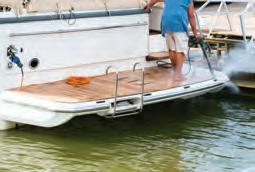











By A. deGruchy


The Florida Keys transform into a fishing paradise as the intense summer hurricane weather fades and cooler fronts begin to roll in. This fall, it’s all about the patch reefs... vibrant underwater gardens teeming with a variety of species. Targeting these patches is incredibly fun and rewarding. You’ll encounter species like snapper and grouper, along with various types of mackerels. Light-action fishing is always a blast,
and in the Keys, there are countless patch reefs to explore.
To find a patch reef, look for shallow spots scattered with coral and sand, typically just a few miles offshore at depths of typically between 1530 feet. For gear, we recommend using a PENN Spinfisher VII 3500-4500 combo. The Mustad 3/0 Demon circle hooks are reliable, and when it comes to bait, live shrimp are unbeatable. It’s all about enjoying the vibes and seeing what you can reel in... mutton snapper, red groupers, porgies, Spanish mackerels, and much more!


This fall will be even more special with the opening of Three Waters Resort in Islamorada. This elegant new destination offers not just stunning accommodations but also brand-new restaurants and a magnificent ambiance. Imagine savoring fresh culinary experiences while soaking up breathtaking waterfront views. After a day on the water, kick back and enjoy a drink at one of the resort’s dining venues or onsite restaurants.
So come on down this fall and get ready for some fun fishing in the Florida Keys. With Three Waters Resort as your home base and Bean Sportfishing Charters as your vessel, you’ll be hooked on the fishing, the food, and the laid-back vibes!






















By Capt. Jack Gohmert
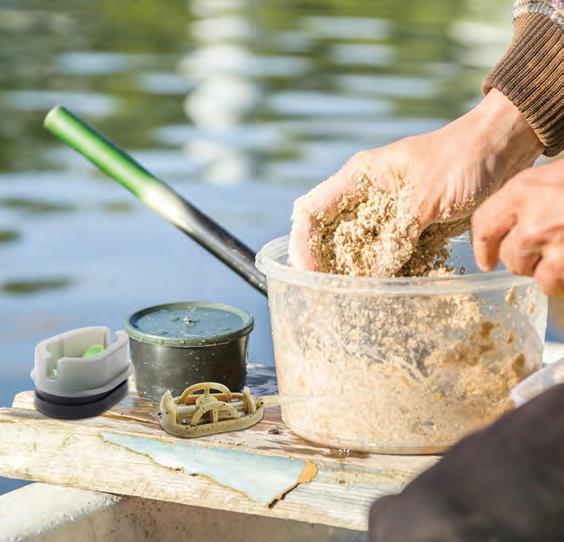
Creating your own chum bait can signifcantly boost your fshing success. Chum, a mixture of fsh parts and attractants, draws fsh to your spot by creating a feeding frenzy. Making your own chum lets you tailor it to the fsh you’re targeting and saves money. Here’s a simple guide to making efective chum and using it for the best results.
Chum is a blend of fsh-based materials that attract predatory fsh. When
placed in water, it forms a scent trail and visual signal that lures fsh like snapper, tuna, and sharks. Whether you fsh ofshore, from a pier, or inshore, chum helps by concentrating fsh around your location.
Making chum is straightforward. You’ll need the following:
Tools:
• Food processor or meat grinder
• Bucket or container
• Rubber gloves
• Freezer bags (for bulk storage)
Ingredients:
• Fish scraps (bait lefovers, carcasses)
• Canned fsh (sardines, mackerel, or tuna)
• Fish oil or menhaden oil
• Breadcrumbs or oats (to bulk up the mix)
• Optional: sand or cornmeal (to sink chum faster)
1. Gather Fish Scraps: Collect lefover fsh scraps or use canned fsh. Local fsh markets are great for sourcing discards.
2. Grind the Ingredients: Use a food processor to grind fsh scraps into a paste. For canned fsh, mash it along with the oil for a strong scent trail.
3. Add Bulk: Mix in breadcrumbs, oats, or cornmeal to bulk up the chum. Tese ingredients absorb oils and create a scent cloud. Sand can help sink the chum.
4. Enhance the Scent: Stir in fsh oil to intensify the scent, making it travel farther underwater.
5. Pack and Freeze: Freeze large batches in bags. When fshing, break of chunks and toss them into the water.
For ofshore fshing, throw small amounts of chum every few minutes to create a steady attractant. For shore or pier fshing, use a chum bag or cage to suspend and slowly release the chum. Adjust the size and consistency of your chum based on the fsh species. Larger fsh prefer coarse chum with chunks, while smaller fsh may respond better to a fne mix that creates a cloud.
Making your own chum is a cost-efective way to improve your fshing. With minimal tools and ingredients, you can craf a bait that attracts fsh and turns a slow day into a successful one.





Being one with the water starts out sometimes with five. Our last trip began on the inside ramp of Flamingo Everglades National Park. This day Jeremy and Jackson from the Coastal Angler Magazine crew with their good friends of Matt and Zane Wahnon took an adventure through the ‘Glades, traveling approximately 24 miles including stops in Coot Bay, Whitewater Bay, some local creeks, and mangrove islands. The day was full of excitement and pretty much nonstop action. For bait, we used live shrimp and artificial jerk baits as they caught at least 20 snook, some goliath grouper, snapper, and some redfish. To me, these days on the water are so very important; making memories we

tckayakfishing.com

November will be the start of the winter species push. Look for pompano, Spanish mackerel, and bluefish to start showing up along the beach with our first few cold fronts. Fish for pompano along channel edges of your favorite inlet. Pompano jigs, D.O.A. Lures 2.75”
Shrimp, and a good ‘ole bucktail jig are a few of my preferred lures. A favorite place to kayak fish for these fish is the Intracoastal north of Jupiter Inlet, east of Jonathan Dickenson State Park.

all share for a lifetime. You can only imagine the stories these kids will tell their kids and so on. What we see and encounter in the ‘Glades such as crocodiles, porpoise, exotic birds, and other wildlife can be talked about for years to come. In the upcoming months the Everglades should cool down a little as cold fronts come down south and the weather will become more tolerable and beautiful. Always check weather forecasts as the high winds usually from cold fronts may be a problem, although there are always places to fish in Flamingo for all circumstances.
FloridaFlatsFishingAdventures.com • (954) 687-5848
FloridaFlatsFishingAdventures@gmail.com


November has traditionally brought me some good wahoo and mahi catches. We typically get good numbers more than size this time of year on the mahi. If you can still find mullet around, I love using them for mahi drifting in 90-150 feet of water. I like to bump up my bait size for the wahoo and slow troll goggle eyes and blue runners in 90-250 feet of water. Try trolling one bait up top on the surface and one 40-80 feet below the surface using a downrigger of a rubber band and egg weight attached to your line. The egg weight will break away when hit and you are free to fight the fish.
Peacock bass and clown knifefish will be chewing this month. Yo-Zuri Prop Baits will work well for peacock along shallow edges. Try twentypound leader and a 2/0 circle hook casting in and around structure and weed lines to get onto a few clowns with finger mullet and shiners. Look to fish mid-water column and below by adding a pinch weight to your leader and get that bait in their face.

Please be sure to check out my YouTube Channel “Darcizzle Offshore” for fishing videos every week! www.youtube.com/DarcizzleOffshore

Beautiful juvenile tarpon that put on a show during the mullet run. Ate a finger mullet & the fish was safely released.
he “mullet run” should be drawing to a close right around the beginning of November. There should still be bull sharks, snook, and tarpon crushing the remaining schools that are migrating through, so this is your last call to get out and enjoy the hot inshore bite. Follow the mullet for excellent snook and tarpon fishing inshore and along the beach. If tarpon and snook are biting, you can catch them on a live mullet using a circle hook or any number of swimming baits and “flair hawks.” I’ve caught many snook and quite a few tarpon using this method.
Offshore, November should start bringing sailfish, wahoo, and bigger-sized mahi mahi into the area. In the Palm Beaches it’s most popular to kite fish with live bait for these pelagic fish, but slow trolling live bait works nearly as well. Trolling ballyhoo and lures will also land you plenty of sailfish and mahi. If it’s calm, head offshore and find some floating debris or other structure that holds bait that the mahi feed on. November weather will bring more northerly winds and cooler, less humid drier weather which translates into rougher seas. If it’s rougher stay close and troll those ballyhoo for sails and mahi from 80-300 feet or deeper depending on water conditions. Look for color changes and temperature breaks.
Closer to shore and on the bottom, fishing has been excellent! The fall run of Spanish mackerel should also be showing up in good numbers and are so much fun to catch on light tackle. The party boats will be coming in with a good number of yellowtails and large mutton snappers. Even mahi mahi have been caught shallow recently, presumably chasing mullet closer to shore than normal. There have been a good number of kingfish landed as well, however bigger kingfish have been missing from the Palm Beaches for several weeks. The drift boats typically use a triple-hook rig with a whole dead sardine as bait. This is a great, yet simple fishing method and it will catch you plenty of fish; I have caught sailfish in the past with this simple rig so don’t count it out when you just want to relax on the water.

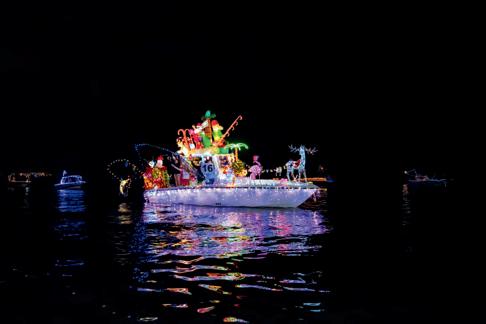












Sea Tow is happy to extend it’s service to include tows from Nothern Bahamas, Green Turtle, West End Marsh Harbour, Hope Town and Grand Cay to the U.S.
Whether you need a timely tow or help offshore, Sea Tow Captains are standing by 24/7.
Why wait? Join today and get 2 months free! (That’s a $28 value!) Use discount code: TCT.
Join Sea Tow Palm Beach \ 561-844-8056



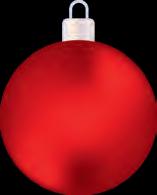











6:00PM

like dude, what did you do in a previous life to deserve this??? We made our way toward a dock that I know holds snook. I made a long cast and right then I was hooked up with a huge sh. It was a big snook; I got her
ALL BOATS ARE INVITED TO ATTEND ALL BOATS ARE INVITED TO ATTEND NO ENTRY FEE! NO ENTRY FEE!
Success! I said, “let’s go to lunch and call it a day”. I asked Neil if he was hungry and then he disclosed to me that he ate a banana for breakfast! Neil knows not to bring bananas on the boat (it’s bad luck), but it didn’t occur to him that the curse would remain in e ect with it digesting in his stomach. Myth con rmed or Keith Lozott

We used the trolling motor to quietly make our way towards the mangroves hoping to get a glimpse of a red, snook, trout, ounder, or any inshore species willing to bite. As we approached the shore, we noticed another bull shark working the shore and of course I had to make a cast or two at him, but he had no interest in my o ering. We kept working the shore and nally it happened for Neil!!! He made a long cast and almost as soon as the lure hit the water, he was on with a nice sh, but we couldn’t see what it was. He started gaining ground getting it closer; enjoying the ght and then it happened! e sh came unbuttoned and at this point I was like dude, what did you do in a previous life to deserve this??? We made our way toward a dock that I know holds snook. I made a long cast and right then I was hooked up with a huge sh. It was a big snook; I got her
SCAN TO REGISTER SCAN TO REGISTER


Success! I said, “let’s go to lunch and call it a day”. I asked Neil if he was hungry and then he disclosed to me that he ate a banana for breakfast! Neil knows not to bring bananas on the boat (it’s bad luck), but it didn’t occur to him that the curse would remain in e ect with it digesting in his stomach. Myth con rmed or Keith Lozott The Fishing Realtor
ive us a try and see what everybody is raving about! We put the “FUN” back into drift boat fishing! time!

Sailing two trips daily, 7 – days a week! 8am – Noon • 1pm - 5pm (Tuesdays 1-7pm) Night trips – Wednesday & Friday 6pm – 10pm seasonally – call for more info. Plenty of free PArking very close to the boAt!
Us & Catch: King Mackerel • Wahoo Dolphin • Snapper (all kinds) Sailfish • Grouper Bonito • Cobia All licensing, bait & tackle included. + gratuity for crew



Well folks, incredibly, it is November, and the end of the year is somehow already in sight. I don’t know about you, but after a long, hot summer and early fall, I’m looking forward to some cooler weather to go exploring!


I’m lucky that I get to spend a lot of my time outdoors and on the water. Although it’s been years since I gave up on corporate life to

start Aqua Adventure Tours, there’s still nothing quite like the feeling of freedom that comes from casting lines and heading out for some adventure. Especially this time of year, when temps finally ease, and the sun feels a little softer overhead.
But here’s the thing - there are a bunch of people who feel the same way I do - especially on picture-perfect sunny days. It tends to get super crowded on the water, and that doesn’t always make for the most relaxing of times. Too. Much. Drama.
On beautiful weather days when I just don’t feel up to dealing with all the Very Important People Nobody Else Enjoys (VIPNEEs) I go a different direction - inland!
There are hundreds of thousands of acres of natural areas here in Palm Beach County, almost all of which are open to the public. Some, like Grassy Waters Preserve, are managed by local cities. But the vast majority of natural areas are managed by Palm Beach County, the State of Florida, and the US Fish and Wildlife Service.

Enjoy some shade while exploring the coastal hammocks at Gumbo Limbo Nature Center and MacArthur Beach State Park. Or try a hike (on cool or cloudy days) through the dune and scrub habitats at Juno Dunes and Jupiter Ridge natural areas. Or trek a little further inland to hike-n-bike amongst the towering pines and palmetto prairies of Riverbend Park and Jonathan Dickinson State Park. You can also rent canoes and kayaks at these two parks to explore the Loxahatchee River.
If you have your own canoe or kayak, you can easily explore the Loxahatchee River as well as some of Palm Beach County’s more remote areas by water. Loxahatchee Slough, which PGA Boulevard bisects, has a well-marked and easy paddling trail which starts at the paddling parking area, located at 8311 PGA Boulevard in Palm Beach Gardens. It’s a gorgeous and easy paddle among mature cypress trees draped with Spanish moss.
These smaller areas are just a small slice of the natural lands open to the public locally. If you’re looking for fewer people and more nature, and don’t want to go all the way down to Everglades National Park or Big Cypress, check out JW Corbett Wildlife Management Area or AR Marshall Loxahatchee Natural Wildlife Refuge.
Bring your camera, a picnic lunch, a good book, and enjoy your day. Hope to see you on the water!
www.swamptosea.com • 561-503-0848

Ira had an incredible morning with five nice tarpon in the first hour and a big snook to follow it up.
shrimp related lure or bait and working the bottom will be key. This is also a great time of year to take home fish for dinner. A lot of these species should taste excellent as the spillways should be closed so the water should be clean unlike during the summer. For fly anglers, this is one of my favorite times to break out the six or eight weight with a full sink line and fish trousers. You never know what you’re going to hook up to bouncing the fly in 20 feet of water along the bottom. It can make for a really exciting morning!
The freshwater bite is going to be awesome while cooler water temps really trigger the peacock bass, sunshine bass, and clown knifefish that will be feeding heavily all the way through December. Some of the best days of the year will be in
You don’t always need a big boat to get on some awesome fish. The 12foot johnboat with a trolling motor is all we needed for some excellent snakehead fishing.

Hurricane season is almost over, and it is a great time of the year to go fishing. November brings big changes to the weather. Cold fronts roll in or I should say cool fronts for us in South Florida. These cool fronts are going to push in migratory species. Jacks, pompano, ladyfish, permit, black drum, giant croakers, and lots more can be found at the inlets. Ultralight tackle is the way to go. Fishing any

Gary had no issue getting the peacocks to cooperate for him.

Light tackle juvenile goliath grouper fishing has become pretty consistent in our area the last couple years.
the next two months. The main difference between summer and fall is you may want to target deeper water for schooling fish rather than docks, sea walls, and shallow bridges. Crank baits, jerk baits, and chrome rattle traps are some of my favorite go-to lures this time of the year. Try ripping and stopping to trigger a reaction bite.
Good luck out there!



Capt. Weston Russell • www.reelintensefishing.com •561-310-2690

November is the start of sailfish season.
Welcome to the November Coastal Angler fishing forecast for the waters from Palm Beach to Jupiter. The mullet run will start to fizzle out, but there will be a few good fish still crushing schools, so, if you’re an inshore angler, this is last call. In October there were a lot of sharks chasing the massive groups of mullet and rumors of a couple of white sharks also feeding on them off Juno Beach. If you’re interested in a toothy creature...don’t forget the wire at the bait store.
For the offshore report, expect some better fishing than the month before. The cooler weather moving down from the north will move some good fishing our way. Sailfish, dolphin, and wahoo will be on the list. This is the time to get that kite reel out and change the swivels. All the fish on this list want to eat live bait, so suspending some from a kite is a fun way to catch one. The bottom fishing this month will also be good. Sardines or squid will work great for snappers, but there is a new player in town, the Gulp Shrimp. Put one of these killer artificial baits on a jig and bounce it around structure...hold on!
One other thing I would like to talk about is the fall run of Spanish mackerel. These sharp tooth fish are fun on light tackle. Use a jig with light wire to up your chances. Be sure to be careful when removing the hook. These are not monsters, but they bite like one. The use of a dehooker helps from losing your fingers. Well, good luck and remember, you can’t catch them from the couch!








2.7 1:48 2.9 7:13 0.7 7:57 1.0 6:33 5:34
9 Sat 2:03 2.7 2:47 2.9 8:22 0.7 9:04 0.8 6:34 5:33
10
4:20 3.0 4:43 3.1 10:35 0.6 11:03 0.3 6:35 5:32 12 Tue 5:22 3.2 5:37 3.2 11:33 0.5 11:56 0.0 6:36 5:32
Wed 6:19 3.4 6:29 3.3 12:27 0.4 6:37 5:31 14 Thu 7:13














22
25
26
with
PhlatsInshoreFishing.com • (561) 644-4371 • Visit us on Facebook & Instagram
Happy Thanksgiving! November starts to bring cooler, comfortable weather. Water temperatures will start to cool down and predator fish begin to push into back bays, canals, and coves.
Snook fishing in Jupiter and Palm Beach will provide anglers steady action along seawalls, mangroves shorelines, and channel edges. Sight fishing on the flats is another option for those who enjoy watching the bite. A D.O.A. C.A.L. 3” Shad or D.O.A. 3” Shrimp presented in the right spot gets the drag screaming.

Fall weather drives tarpon into back bays and canals offering excellent fishing for the silver king. Tarpon are prevalent inside the ICW, mangrove shorelines, docks, and deep passes. Live shrimp drifted with the tide is the best bait, other baits like mullet, pinfish, and greenies will work as well. Artificial enthusiasts, the deeper passes offer plenty of shots on D.O.A. Bait Busters or D.O.A. C.A.L. 3” Shad Tail. Tarpon this time of year range from 10 to 60 pounds.
November offers great action for big jack crevalle on the ICW. Jacks will pounce on Rapala Skitter Walks or live bait in the vicinity of seawalls, docks, or open water flats. The jacks are schooling fish averaging 5 to 25 pounds. Battling jacks on light tackle or fly is something an angler will never forget, come experience the tussle yourself.
Well, that is the fishing report for the Palm Beach and Jupiter area. I hope you all enjoyed. Get out there and get hooked up. Tight Lines!























































Pompano Beach (Hillsboro Inlet), FL - Nov 2024
1
2
3
6
www.USHarbors.com










































































































ShoreStation hydraulic boat lifts are a reliable choice for coastal residents and boating enthusiasts alike. Their strong construction, made with corrosion-resistant materials, allows them to withstand harsh environmental conditions, including sun, storms, and saltwater damage. ShoreStation provides a steadfast solution for protecting waterfront investments, ofering peace of mind to owners in the Sunshine State.
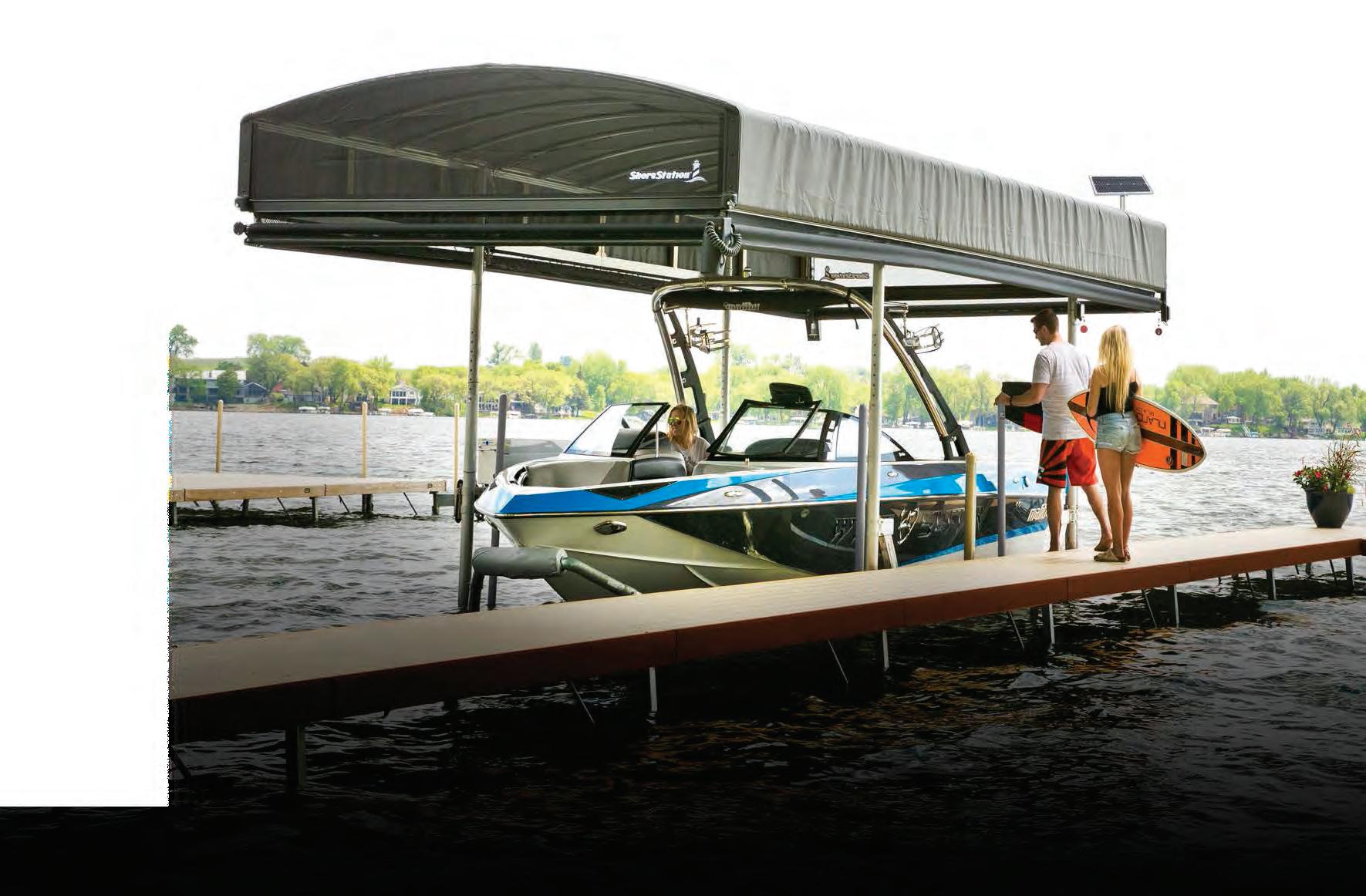







Equipped with exceptional weather resistant fabric and breathable SunTex 80 woven mesh ends for maximum protection and durability,

Made from the highest quality materials, our innovative hydraulic boat lift is one of the fastest and safest lifts on the market today. When you have a hydraulic lift, there’s no need to worry about wind and waves getting in your way. This lift will give you confdence to safely land and secure your boat in less-than-ideal conditions.
Never miss another moment on the water. Power your lift with clean, free solar power. Our speedy 20 watt charger features solar regulator drainage protection, saving your battery from permanent damage caused by overcharging.





















By Dr. Sal Benezo






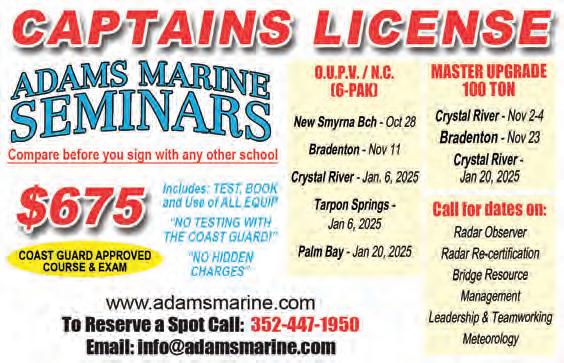
During a hurricane, fsh experience dramatic changes in their environment that can afect their behavior, habitat, and survival. As the atmospheric pressure drops with an approaching hurricane, the water pressure at diferent depths also changes. Fish have swim bladders that help regulate buoyancy, and the rapid changes in pressure can afect how they swim and maintain their depth. Some fsh may dive deeper to avoid the surface turmoil.
Hurricanes churn up sediment from the seabed, making the water murkier. Tis can reduce visibility, afecting how fsh fnd food and avoid predators. In coastal areas, this turbidity can also carry pollutants and toxins from land runof, negatively impacting the water quality.
Hurricanes generate powerful underwater currents and massive waves. Many fsh seek refuge in deeper waters, coral reefs, or underwater structures to avoid being swept away. Shallow-water fsh may struggle more to fnd shelter from the turbulence, which could lead to displacement or death.
Hurricanes ofen bring a rapid infux of fresh water from rain and runof, lowering the salinity of coastal waters. Some species, especially those adapted to certain salinity levels, may be stressed or forced to move to more stable areas. Additionally, the mixing of ocean layers can lead to changes in water temperature, which can afect fsh metabolism and spawning behaviors.
Te disturbance of the water column can disrupt oxygen levels, particularly in areas where organic matter from land washes into the ocean. Decomposing plant material can deplete oxygen in the water, creating hypoxic (low oxygen) zones, which can force fsh to fee or risk sufocation.
Fish, especially schooling species, may instinctively move to safer waters before or during a hurricane. Some species seem to sense the change in barometric pressure and migrate to deeper or more sheltered areas ahead of the storm. However, fsh that get caught in the turbulent water may end up displaced far from their usual habitat.
Afer a hurricane, habitats may be altered signifcantly. Coral reefs, seagrass beds, and mangroves—essential fsh habitats—can be damaged, leading to long-term impacts on fsh populations. However, hurricanes can also bring benefts, such as replenishing nutrients and oxygen in certain water bodies, which can stimulate plankton growth and temporarily improve food availability for fsh.
Fish have evolved to withstand many natural disturbances, including hurricanes, but the intensity and frequency of storms can have lasting efects on fsh populations, particularly for those in fragile ecosystems.



TRACY PATTERSON
Costa Rica is a renowned destination for anglers, ofering calm seas, ideal fshing conditions, and worldclass fshing. It is especially popular among female anglers due to its safety, tournaments, and supportive crews, making it an unforgettable experience.
If you’re seeking high odds of catching billfsh, Costa Rica is the place to be. On a full day ofshore, it’s common to get multiple strikes. Te fat, calm seas make it enjoyable for anglers of all levels, letting you focus on reeling in catches rather than battling rough waters.
Costa Rica hosts two ultra prestigious women-only tournaments: the Ladies Angler Tournament at Los Suenos Resort and Marina, and the Pescadora Billfsh Championship at Marina Pez Vela. Both tournaments create a supportive

yet competitive environment for anglers of all skill levels. Te Pescadora Championship is
particularly unique, ofering two Female Angler of the Year awards based on diferent fshing techniques. It encourages women to challenge themselves and grow in the sport.
Costa Rica is ranked #1 in Central America for safety, and recent laws further protect women from harassment. Female anglers can feel comfortable walking around resorts and marinas. Charter feets also adhere to strict safety regulations, ensuring peace of mind while on the water.

Whether you’re staying at a boutique hotel or a private home, Costa Rica ofers a range of accommodations for groups of all sizes. Many resorts are conveniently located near marinas, allowing easy access to fshing trips and other adventures.
Costa Rica is home to many women who support the lady angler movement. Te captains and crews are eager to teach beginners, helping them hook their frst billfsh or refne their skills. With women accounting for a growing percentage of anglers, Costa Rica ofers a welcoming and empowering environment for female anglers.
Whether you’re an experienced angler or a frst-timer, Costa Rica ofers an unbeatable fshing experience. Its exceptional conditions, tournaments, safety, and camaraderie make it the top destination for lady anglers.






IBy Capt. Michael Okruhlik
t’s that thrilling time of the year, founder time! Te fall migration, reaching its peak in November along the Gulf Coast, promises an exciting infux of founder to their spawning grounds. Louisiana, following Texas, has also implemented a closed season during this peak run. But remember, the inability to keep fatties during this time doesn’t dampen the thrill of catching them.
Flounder will be migrating into the Gulf during this time, so the apparent ambush areas will be around passes that lead to the Gulf. Te founder will position themselves in diferent regions based on the tide level and current strength. In addition to using their burying-in-the-sand ambush technique, they also utilize structure in several ways.
First, any object that protrudes above the bottom is a great ambush point. Tis ofers a current break for forage fsh to gather directly above a buried founder, making for an easy meal. Objects such as bulkheads are also great ambush points. Flounder like to position themselves against the solid barrier and I think this can be for two separate reasons depending on what other factors are at play. As mentioned above, it could be a current break, especially if the bulkhead has a corrugated shape. When a founder settles against a bulkhead, its prey has less direction in which it can fee, allowing the founder greater odds of capturing it. When targeting founder, never pass up a bulkhead.
Secondly, founder can be caught using a variety of lures and live bait, especially if you keep it in contact with the bottom to increase your chances of a strike. When it comes to live bait, a frisky mullet is your best bet for landing a larger founder. If you’re aiming for a trophy, this is the way to go. Personally, I prefer fshing with lures, particularly the paddle tail style. Jerk-style sof plastics and bucktails can also be efective when worked in the same manner.
If I had to pick a tide to maximize my time on the water, I would choose a medium fow outgoing. Although there are no set rules that fsh always follow, I feel the founder feed more on their way out to the gulf, utilizing

the current to ease their journey. Contrary to the incoming tide, they bury themselves rather than fght against the current.
Don’t let the closed season discourage you from targeting founder during this migration; it will have its advantages. Going forward we will undoubtedly have a larger founder population, but the instant gratifcation will be a lot less trafc in our favorite founder spot! I will use the closed season to target a new personal best this season, as should you.
Capt. Michael Okruhlik is the inventor of Knockin Tail Lures® and the owner of www.MyCoastOutdoors.com.











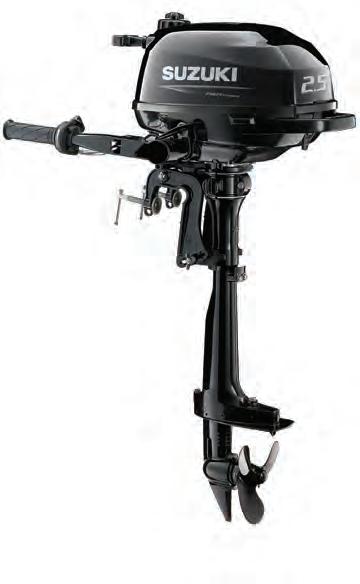








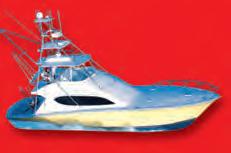


OTim Barefoot

f course, October is when it all starts, but if you like to bottom fsh, then November is the month the turbo kicks in, leading to the crescendo of the year… December. I’ve always said the week of Christmas is the apex of the grouper fshing calendar, and I’ll stand by that statement now. Tis is when larger (male) gags move inshore to establish their territory on inshore ledges, wrecks, and live bottom, much like buck deer making scrapes and rubs to mark their territory. Tese males now wait for the smaller females to show up in numbers to spawn, and the bite traditionally goes of the charts.
A small piece of hard bottom can attract large numbers of fsh if it contains the right ingredients. First and foremost, you need to locate their food. Go to the places that have traditionally held the bait—cigar minnows, sardines, beeliners, etc. “Find the bait, fnd the fsh” has been my thought process for years. Tese fsh won’t show up to a party without food—common sense. You can anchor up on a stack of bait without seeing a big mark of fsh, but afer a few bites, you’ll notice the screen light up with more and more fsh showing up.
Anchoring up is key to shallow water grouper fshing. Te sound of fsh feeding travels great distances and doesn’t go unnoticed. Once an area is fred up, constant bites supercharge the atmosphere down there. If you’re drifing, you won’t get a specifc area fred up; you’ll only go back where you got bites. But if you anchor, the fsh come to you to join in. Tis draws the alpha predators—big sharks. Yes, you’ll lose some fsh and tackle to these bruisers, but enjoy the ride while it lasts. When sharks show up, it’s time to move on to another ledge or further down the same one.

Back to noise... Keep in mind that while we hear very little, fsh hear everything. Sound travels far underwater, and everything you do on deck—slamming cooler lids, dropping hard objects, loud music, yelling—is heard by the fsh. It could be the diference between catching smaller cows or big bulls. Large male groupers didn’t get old by being dumb. You don’t kill big bucks by being noisy, so treat your fshing with the same respect.
Te folks that target grouper come home with grouper. Te ones who go “bottom fshing” with cut bait and chicken rigs come home with “bottom fsh.” As Franklin Covey said, “begin with the end in mind.” If you’re targeting grouper, think and act like it. Put baits on the bottom that avoid trash bites. Spend time jigging up some of that “trash” and drop them back down on a Decoy Jig for optimal results. Watch some of my videos on YouTube (Tim Barefoot) for examples of what I’m saying.
For more information, visit barefootcatsandtackle.com.





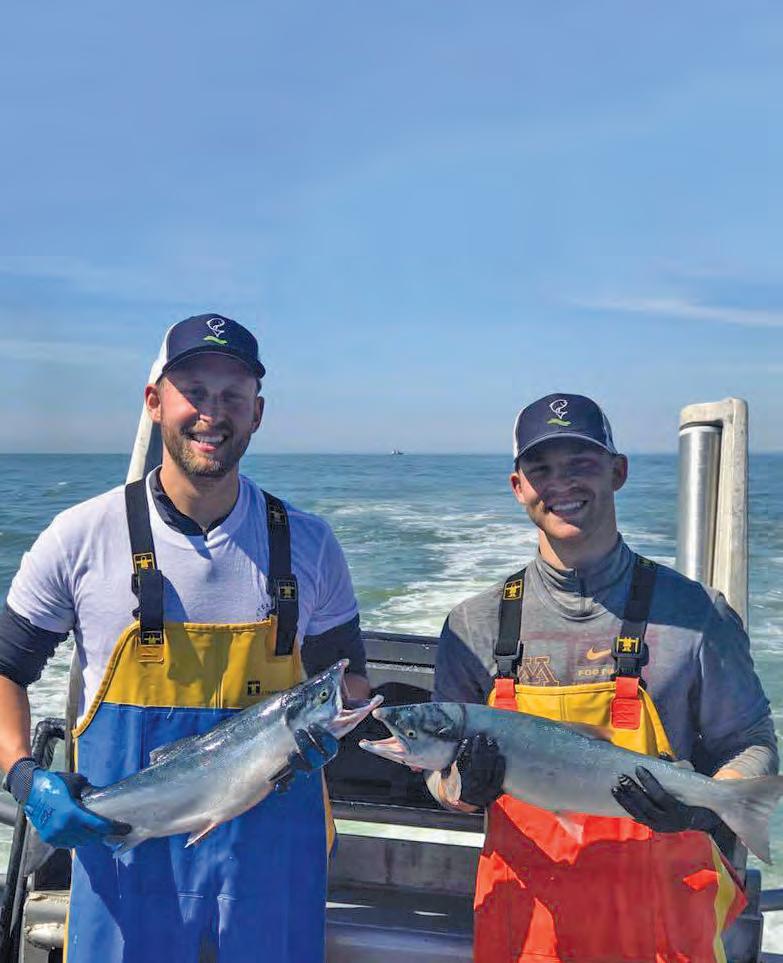















You want AI Routing! Let TZ MAPS with AI Routing make route planning a snap. Don’t take our word for it. Scan here to see for yourself how easy it is!